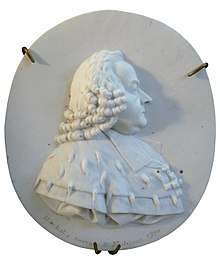Biscuit (pottery)

Biscuit[1][2][3][4][5] (also known as bisque) refers to pottery that has been fired but not yet glazed. Biscuit is any pottery that has been fired in a kiln without a ceramic glaze. This can be a final product such as biscuit porcelain, or unglazed earthenware, often called terracotta, or, most commonly, an intermediary stage in a glazed final product.
The porous nature of biscuit earthenware means that it readily absorbs water, while vitreous wares such as porcelain, bone china and most stoneware are non-porous even without glazing.[6] The temperature of biscuit firing is today usually at least 1000°C, although higher temperatures are common.[7] The firing of the ware that results in the biscuit article causes permanent chemical and physical changes to occur. These result in a much harder and more resilient article which can still be porous, and this can ease the application of glazes.
The first firing is called the biscuit firing (or "bisque firing"), and the second the glaze or glost firing.
References
- ↑ "New And Latest Biscuit Firing Technology". Ceramic Forum International. 87 (1–2): E33–E34, E36. 2010. Table of Contents for volume 87.
- ↑ Kara, Alpagut (2004). "An Investigation Into Bloating Behaviour Of Bone China Body During Biscuit Firing". Key Engineering Materials. 264-268: 1717–1722. doi:10.4028/www.scientific.net/KEM.264-268.1717.
- ↑ Kara, Alpagut; Stevens, Ron (2003). "Interactions Between A Leadless Glaze And A Biscuit Fired Bone China Body During Glost Firing—Part III: Effect Of Glassy Matrix Phase". J. Eur. Ceram. Soc. 23 (10): 1617–1628. doi:10.1016/S0955-2219(02)00403-X.
- ↑ Plešingerová, Beatrice; Klapáč, Miroslav; Kovalčíková, Miriam (2002). "Moisture Expansion Of Porous Biscuit Bodies – Reason Of Glaze Cracking" (PDF). Ceramics-Silikáty. 46 (4): 159–165.
- ↑ Dale, Alfred J.; German, William L. (1964). Modern Ceramic Practice. Maclaren & Sons.
- ↑ Dodd, Arthur E.; Murfin, David (1994). Dictionary Of Ceramics (3rd ed.). Institute Of Minerals. ISBN 9780901716569.
- ↑ Ryan, William; Radford, C. (1987). Whitewares Production, Testing, and Quality Control: Including Materials, Body Formulations, and Manufacturing Processes. International Series on Systems and Control. Pergamon Press on behalf of the Institute of Ceramics (Great Britain). ISBN 9780080349275.
External links
| Wikimedia Commons has media related to Biscuit porcelain. |